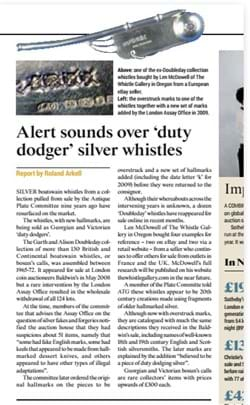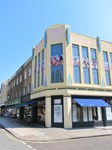The committee was set up by the London Goldsmiths’ Company in 1939; its role is to advise the company as to whether articles of second-hand and antique hallmarked silver and gold comply with the Hallmarking Act.
The desire was to clean up a market cluttered with what was then termed ‘spurious plate’: that is to say articles which bore fake or inserted hallmarks, or whose purpose had been altered since hallmarking.
Making ‘improvements’
When a market for ‘antique’ silver developed in the 19th century it was then thought acceptable to ‘improve’ pieces by adding decoration or by extensive alteration.
An interest in early spoons led to the creation of large numbers of ‘seal top’ or ‘apostle’ spoons by re-shaping 18th century tablespoons and adding a cast finial.
Mugs and lidded tankards were turned into jugs by the addition of lips. Pap boats were converted into sauce boats with the addition of cast legs and a handle. Punch ladles became miniature bowls with cast handles. Dishes from epergnes were given feet and turned into individual pieces.
“More important is confidence in the market for antique silver – a market plagued by fakes, forgeries and alterations is directly diminished
Some in the trade moved from alteration to faking and, at the end of the 19th century, two silversmiths, Reuben Lyon and Charles Twinam, were found to have used fake punches to manufacture quantities of ‘antique’ silver. Lyon and Twinam fakes still turn up with some regularity.
The hallmarking acts were revised in 1973 and now state that it is an offence to make an addition, alteration, or repair to a hallmarked article, or to remove or alter the hallmarks on that article without the written consent of an assay office unless (a) for the purpose of breaking up the article for scrap; (b) the alteration does not change the character of the article; (c) any metal added is of the same standard as the original and does not exceed 5 grams of silver, or 1 gram of gold.

ATG’s story about the boatswain whistles that reappeared on the market after being pulled from sale in 2008 by the Antique Plate Committee.
The act also makes it clear that it is an offence ‘for any person knowingly or any dealer to supply or offer to supply any article’ which would, in the opinion of an assay office, be in contravention of the hallmarking act.
Nevertheless, the hallmarking act is neglected, ignored or evaded by both dealers and auctioneers [with a few notable exceptions].
Few auction rooms employ specialist cataloguers. Most are willing to withdraw offending pieces from sale but very few encourage their vendors to then send the articles into the assay office to be checked. As a consequence, the same articles appear at a later date in another auction.
Criminal prosecution, under the Hallmarking Act, is unusual but auctioneers and dealers who sell pieces which are later found to be illegal risk financial loss. Much more important, however, is confidence in the market for antique silver. A market plagued by fakes, forgeries and alterations is directly diminished.
Seminar support
I would urge auctioneers to send their silver cataloguers to the Fakes and Forgeries seminars which are held by the Goldsmiths’ Company in London.
I also hope that dealers, auctioneers and private vendors will take a more active part in ridding the market of fake or illegally altered silver by sending any pieces that they suspect [or know] to be in contravention of hallmarking law to the Goldsmiths’ Company in London to be put before the Antique Plate Committee.
Peter Cameron
London Silver Vaults












